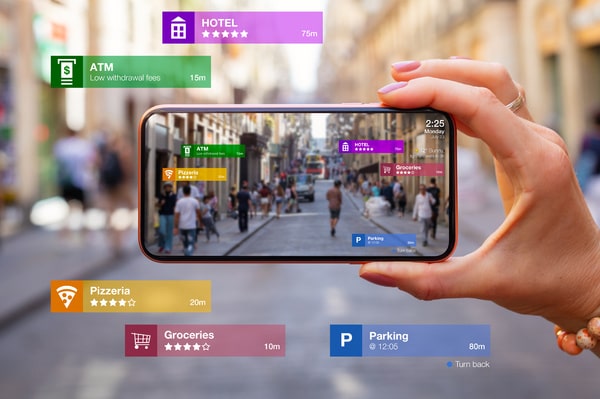Location data holds incredible power. It reveals patterns, uncovers opportunities, and helps you make smarter decisions – whether you need to optimize delivery routes, select a store location, or target the right customer at just the right moment. But even the best location data can’t drive results if it’s trapped in silos, out of sync, or delivered too late.
That’s where data integration comes in.
Whether you’re building customer-facing apps, streamlining operations, or training AI models, success depends on having reliable, real-time access to your location data across the business. And for many, that’s still a major hurdle.
Read on to find out more about some of the biggest integration challenges today, how to overcome them, and explore top use cases to inspire the next step in your journey to getting the most out of your location data.

What’s Holding You Back? Today’s Top Location Data Integration Challenges
Today, location data is everywhere within your business. It’s feeding dashboards, powering personalization, driving analytics, and informing strategy. But there’s a big difference between having data and being able to use it.
When location data is isolated in outdated systems or stuck in legacy pipelines, it leads to challenges that can have major downstream impacts:
- Incomplete or delayed information
- Gaps in operational visibility – especially for location-critical processes like supply chain, product & service delivery, and risk assessment
- Bias or inaccuracies in AI outputs due to a lack of contextual relevance
- Poor customer experiences due to latency or inconsistency
Location data comes in many forms – each with unique structures, formats, and refresh cadences.
Geospatial data from GIS systems might include shapefiles and raster imagery. Places data represents everything from retail storefronts to EV charging stations, constantly changing and sourced from disparate vendors. Parcel and property records offer rich context for zoning, ownership, and risk – but often reside in local government systems with outdated formats.
Bringing these datasets together isn’t as simple as syncing files. They may use different coordinate systems, refresh on different schedules, or require domain-specific enrichment.
And as data volumes grow, the stakes only get higher. Here are some of the biggest integration challenges we hear about from businesses today:
1. Siloed systems and legacy formats
Location data lives in more places than ever – mainframes, GIS platforms, CRM systems, and proprietary apps. And because it’s often tied to physical assets or customer locations, these systems must work together to provide timely, context-rich insights. However, these systems rarely speak the same language. Older pipelines and inconsistent formats make integration a fragile and frustrating process.
2. “One-size-fits-none” approaches
Some organizations try to force all data through a single, rigid integration method. Others take a case-by-case approach, resulting in a patchwork of custom solutions that are costly to maintain and update. Neither strategy scales well.
3. Hard-to-access, high-value data
Critical enterprise data – especially from platforms like IBM i, SAP, or Oracle – is often the hardest to reach. Yet without it, your analyses are incomplete, your AI models are limited, and your operations are less efficient than they could be.
You can’t afford to overlook issues like these and miss out on the value your data holds, particularly when it comes to AI initiatives. AI is now a top priority for organizations of all kinds, but without a solid data foundation, it’s a risky bet. Generative AI in particular depends on having complete, current, and contextual data.
When integration breaks down, the consequences can ripple through every AI initiative. Models trained on incomplete data or datasets that lack real-world context can introduce bias, while missing data leads to hallucinations that erode trust in the results. Not to mention, slow or inaccurate responses lead to flawed decisions and customer experiences that fall short of high expectations.
- To drive real AI-powered innovation, you need to deliver location data (and all enterprise data) where it’s needed – quickly, securely, and reliably.
Webinar
A Day in the Life of Location Data: Turning Where into How
Discover how location data—when properly managed—can unlock operational efficiency, elevate customer experiences, and fuel business transformation at scale.
Best Practices for Location Data Integration
A modern data integration strategy makes your location data manageable and impactful across the business. That requires a flexible, future-ready approach that empowers your business to leverage the power of location wherever and whenever it’s needed, without compromise.
As you build your strategy and choose the best data integration solutions for your needs, keep these things in mind:
✔️ Deploy where your data lives. Replicate where it’s needed.
You shouldn’t have to move mountains just to move data. A modern integration strategy lets you design pipelines wherever your data resides – whether on-premises, in the cloud, or across hybrid environments. Whether your location data is stored on a mainframe, in a spatial database, or across multiple platforms, you need the freedom to:
- Build pipelines without being limited by infrastructure constraints
- Feed your applications with complex, disparate data in real time
- Scale across teams, systems, and use cases – without redesigning pipelines from scratch
This flexibility not only boosts speed to insight but also helps reduce risk and cost as your environment evolves.
✔️ Deliver data in real time – reliably and securely
Slow data is stale data. Your business decisions, customer interactions, and AI models all depend on current information. That’s why reliable, real-time replication is a must.
Modern integration solutions provide:
- High-throughput pipelines that meet demanding SLAs
- Secure delivery with end-to-end encryption
- Data lineage and tracking to ensure transparency and auditability
When you know your data is fresh and trustworthy, you can act with confidence.
✔️ Support hybrid environments with flexible architecture
Most organizations aren’t “either/or” when it comes to infrastructure. You’re likely running a mix of cloud-native apps and legacy systems (each with its own quirks). The right integration solution meets you where you are.
Look for:
- Broad support for platforms like IBM i, SAP, Oracle, and GIS
- Compatibility with leading cloud providers and data lakes
- Options to deploy on-prem, in hybrid SaaS, or in private cloud setups
You should never have to choose between performance and flexibility.
✔️ Empower users with scalable, self-service access
Integration is also about connecting the people on your teams to the data they need to do their jobs. That includes developers building new services, analysts surfacing insights, and data scientists training models.
The ideal solution should:
- Enable self-service access to trusted, real-time location data
- Reduce dependence on specialized personnel or fragile, homegrown solutions
- Scale easily as your business grows and your data demands increase
By empowering more people to access the right data at the right time, you turn integration into a force multiplier across your organization.
Real-World Wins: 3 Use Cases for Location Data Integration
With better integration, you unlock impactful outcomes – from faster innovation cycles and improved performance across systems to reduced risk and greater confidence in data quality and IT delivery.
- Let’s take a look at three top use cases that show the power of data integration in action.
1. Modernizing legacy architectures
Organizations migrating from aging platforms like mainframe or SAP to modern cloud environments need to move fast, and any disruptions can result in financial penalties, reduced customer satisfaction, and damage to the brand. Integrated location data ensures:
- Business continuity during migration
- Access to historical context for analytics and AI
- The ability to sunset legacy systems without losing value
2. Driving operational efficiency
From logistics and field operations to network planning and site selection, internal teams need real-time access to accurate location data to keep operations running smoothly. Integration enables:
- Self-service data access across teams
- Reduced bottlenecks and development delays
- Better insights and decision-making
3. Fueling AI and analytics with complete context
AI models are only as good as the data they’re fed. They need access to data from core transactional systems – but the problem is that there’s a disconnect between these transactional systems and the cloud-native platforms where AI models are typically built. Integration makes it possible to:
- Replicate data to the cloud in real time
- Minimize bias and blind spots, for more trusted outcomes
- Train models on the full enterprise picture – including geospatial data tied to customer behavior, asset movement, or risk exposure
Building Business Value: Why Location Data Integration Matters Downstream
Getting location data integrated properly directly impacts how the business runs and grows.
Retailers can pair demographics and customer movement data to optimize new store placements. Insurance carriers can combine parcel attributes with weather patterns and claims data to improve underwriting accuracy and detect fraud. Product and service delivery teams rely on clean customer address data – ensuring on-time arrivals and better customer experiences.
But none of this is possible if the data remains fragmented or delayed. Integration isn’t just a backend function – it’s the connective tissue that ensures your location data is trustworthy, current, and actionable.
Drive Smarter, Location-Driven Outcomes
You already know where your data lives – but that’s just the beginning. Now, it’s time to unlock its full potential by connecting location data from all over your data landscape.
When you break down the silos that hold you back, you gain location intelligence that moves as seamlessly as your business demands – powering everything from improved decision-making to smoother customer experiences. And it sets the foundation for innovations in AI, automation, and beyond.
Ready to take the next step? Find out how our data integration solutions deliver real-time, trusted location data from complex sources to cloud platforms – supporting hybrid environments, legacy systems, and high-volume replication.
And for even more insights, join our upcoming webinar to follow a “day in the life” of location data: how it moves through systems, supports smarter decisions, and helps organizations like yours move forward, faster.







